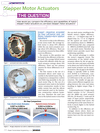Stepper Motor Actuators
Stepper Motor Actuators
How would you compare the efficiency and capabilities of hybrid stepper motor actuators vs. can stack stepper motor actuators?
The answer to this is the efficiency of the motor itself. The average hybrid motor is about 65% efficient while the can stack actuators average about 25% efficiency. There are two primary reasons for these differences in efficiency.
The answer to this question can be found in the efficiency of the motor itself. The average hybrid motor is about 65% efficient while the can stack actuators average about 25% efficiency. There are two primary reasons for these differences in efficiency.


The first reason is the use of a laminated silicon steel stator assembly in the hybrid motor (Fig. 1), compared to a stamped low-carbon steel field ring assembly in the can stack motor (Fig. 2). The use of a laminated stator stack in the hybrid motor construction results in less eddie current loss and the silicon steel material used in the lamination construction reduces hysteresis loss. Therefore the total iron loss in the hybrid motor is less than the can stack motor, resulting in the hybrid motor’s higher efficiency. series, i.e. — 1.8 degree/step and .9 degree/step (vs. 7.5 or 15 degrees for the typical can stack) will allow resolutions down to .000060 in. [0.001524 mm]/full step compared to .00025 in.[0.00635 mm]/full step in a can stack motor. Therefore the hybrid motor provides much finer positioning capability.
The second advantage is within the motor’s magnetic circuit. The construction of the hybrid motor actuators allows for the air gap between the rotor and stator assembly to be about one-half of what the can stack motor actuator can be manufactured to. The air gap in the hybrid design is typically 0.003 to 0.004 inch [0.0762 to 0.1016 mm], compared to 0.007 to 0.008 inch [0.1778 to 0.2032 mm] in the can stack construction. The smaller air gap provides a more efficient magnetic coupling between the rotor and stator, resulting in higher torque (Figs. 3 and 4).








